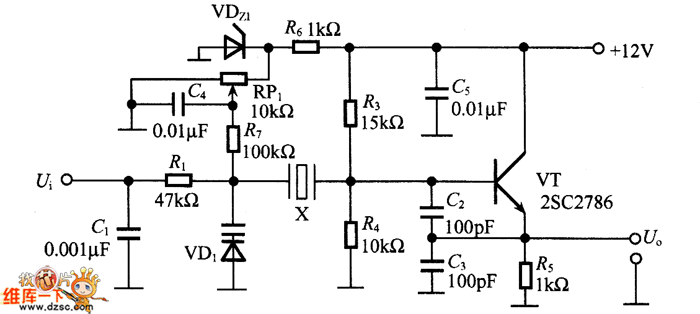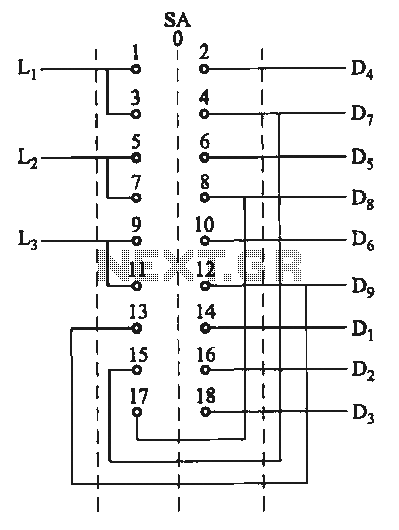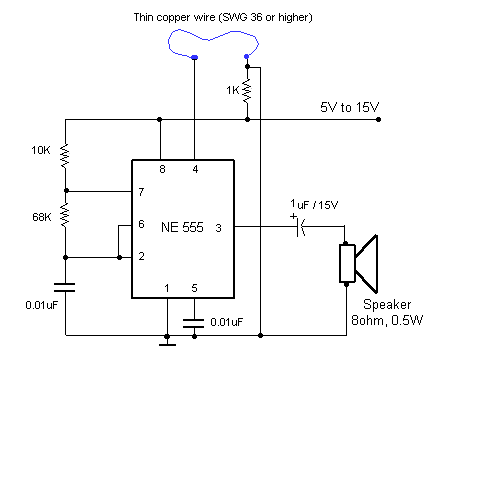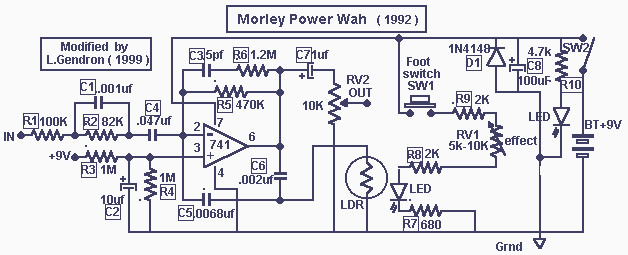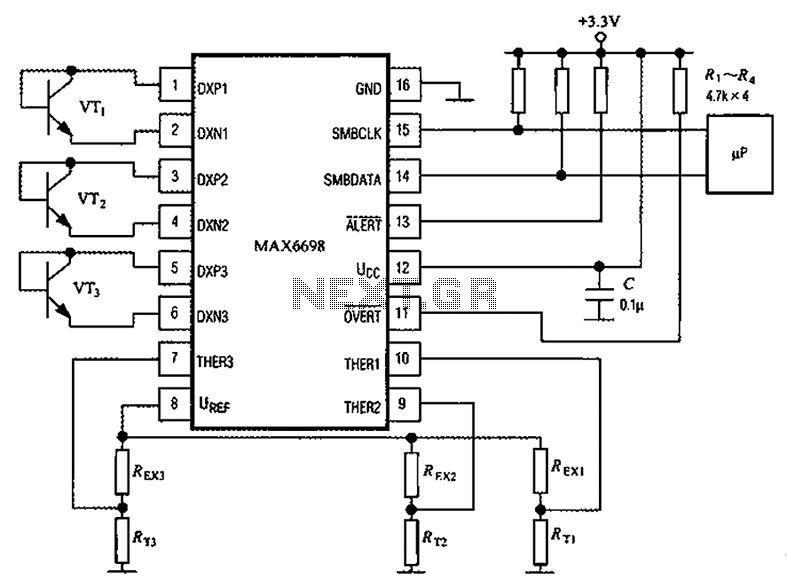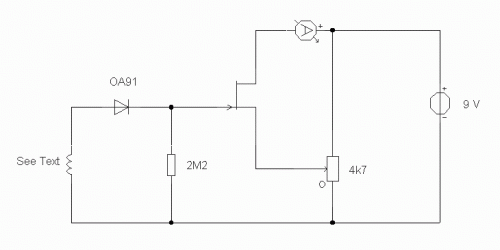
Ionization smoke detector circuit using A5367
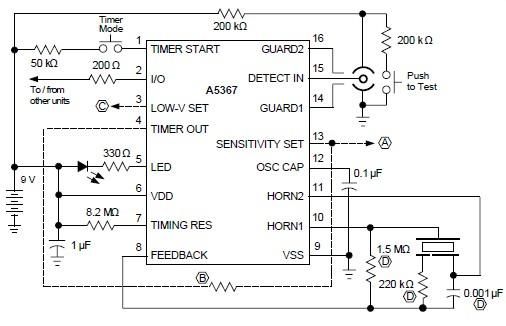
A simple ionization smoke detector with interconnect and timer alarm circuit can be constructed using the A5367 low-current, CMOS circuit, which provides all essential features for an ionization-type smoke detector. This CMOS IC, manufactured by Allegro MicroSystems, includes interconnect features that allow up to 125 units to be interconnected, ensuring that if one unit detects smoke, all units will sound their alarms. Additionally, special features are incorporated to facilitate the alignment and testing of the finished smoke detector. The detector requires a 9-volt DC power supply or a 9-volt battery. The circuit requires a few external components and is easy to configure. An external resistor at point A adjusts sensitivity for a specific smoke chamber, while a selected resistor at point B reduces sensitivity during Timer mode. A resistor to VSS or VDD may be added at point C to modify the low battery voltage threshold. An internal timer is provided that can be used in various configurations to allow a period of reduced smoke detector sensitivity, referred to as Timer (or Hush) mode. Internal test circuitry allows for a low battery check by holding the FEEDBACK and OSC CAP pins low during power-up, then reducing VDD and monitoring the HORN1 pin.
The ionization smoke detector circuit utilizing the A5367 IC is designed for efficiency and reliability in smoke detection applications. The A5367 operates with low power consumption, making it suitable for battery-operated devices. The interconnect feature is particularly advantageous in residential and commercial environments, where multiple detectors can be installed to form a comprehensive safety network. When smoke is detected by any unit, the interconnected system ensures that all alarms are activated, providing an immediate alert to occupants.
The configuration of the circuit is straightforward, requiring minimal external components, which contributes to its ease of assembly. The sensitivity of the smoke detection can be fine-tuned using the external resistor connected at point A, allowing for customization based on the specific characteristics of the smoke chamber used. This feature is crucial for optimizing performance in various environments, such as kitchens or workshops, where false alarms can be a concern.
The Timer mode, activated by the resistor at point B, allows for temporary reduction in sensitivity, which can be useful in situations where brief disturbances may occur, such as during cooking. This functionality enhances user experience by minimizing unnecessary alarms while still maintaining a level of vigilance against smoke detection.
The low battery voltage threshold can be adjusted using a resistor connected at point C, which ensures that the device operates effectively until the battery is critically low, at which point the internal test circuitry can signal the need for a battery replacement. This proactive monitoring feature is essential for maintaining the reliability of the smoke detector over time.
Overall, the A5367-based ionization smoke detector provides a robust solution for fire safety, combining advanced features with user-friendly configuration, making it an ideal choice for both residential and commercial applications.A very simple Ionization Smoke Detector with Interconnect and Timer alarm circuit can be constructed using the A5367 low-current, CMOS circuit that provides all of the required features for an ionization-type smoke detector. A very nice thing at this ionization smoke detector circuit CMOS ic manufactured by Allegro MicroSystems is the interconnect
ion features, which allows as many as 125 units to be interconnected so that if any unit senses smoke all units will sound their alarm. In addition, special features are incorporated to facilitate alignment and test of the finished smoke detector.
This detector needs to be powered by a 9 volts DC power supply (or a 9 volts battery ). Circuit require few external components and is very easy to be configured. Use an external resistor in point A to adjust sensitivity for a particular smoke chamber. Select resistor from point B is to reduce sensitivity during Timer mode. A resistor to VSS or VDD may be added to point C pin to modify low battery voltage threshold. An internal timer is provided that can be used in various configurations to allow a period of reduced smoke detector sensitivity, referred to as Timer (or Hush) mode. Internal test circuitry allows low battery check by holding the FEEDBACK and OSC CAP pins low during power-up, then reducing VDD and monitoring the HORN1 pin
🔗 External reference
The ionization smoke detector circuit utilizing the A5367 IC is designed for efficiency and reliability in smoke detection applications. The A5367 operates with low power consumption, making it suitable for battery-operated devices. The interconnect feature is particularly advantageous in residential and commercial environments, where multiple detectors can be installed to form a comprehensive safety network. When smoke is detected by any unit, the interconnected system ensures that all alarms are activated, providing an immediate alert to occupants.
The configuration of the circuit is straightforward, requiring minimal external components, which contributes to its ease of assembly. The sensitivity of the smoke detection can be fine-tuned using the external resistor connected at point A, allowing for customization based on the specific characteristics of the smoke chamber used. This feature is crucial for optimizing performance in various environments, such as kitchens or workshops, where false alarms can be a concern.
The Timer mode, activated by the resistor at point B, allows for temporary reduction in sensitivity, which can be useful in situations where brief disturbances may occur, such as during cooking. This functionality enhances user experience by minimizing unnecessary alarms while still maintaining a level of vigilance against smoke detection.
The low battery voltage threshold can be adjusted using a resistor connected at point C, which ensures that the device operates effectively until the battery is critically low, at which point the internal test circuitry can signal the need for a battery replacement. This proactive monitoring feature is essential for maintaining the reliability of the smoke detector over time.
Overall, the A5367-based ionization smoke detector provides a robust solution for fire safety, combining advanced features with user-friendly configuration, making it an ideal choice for both residential and commercial applications.A very simple Ionization Smoke Detector with Interconnect and Timer alarm circuit can be constructed using the A5367 low-current, CMOS circuit that provides all of the required features for an ionization-type smoke detector. A very nice thing at this ionization smoke detector circuit CMOS ic manufactured by Allegro MicroSystems is the interconnect
ion features, which allows as many as 125 units to be interconnected so that if any unit senses smoke all units will sound their alarm. In addition, special features are incorporated to facilitate alignment and test of the finished smoke detector.
This detector needs to be powered by a 9 volts DC power supply (or a 9 volts battery ). Circuit require few external components and is very easy to be configured. Use an external resistor in point A to adjust sensitivity for a particular smoke chamber. Select resistor from point B is to reduce sensitivity during Timer mode. A resistor to VSS or VDD may be added to point C pin to modify low battery voltage threshold. An internal timer is provided that can be used in various configurations to allow a period of reduced smoke detector sensitivity, referred to as Timer (or Hush) mode. Internal test circuitry allows low battery check by holding the FEEDBACK and OSC CAP pins low during power-up, then reducing VDD and monitoring the HORN1 pin
🔗 External reference
